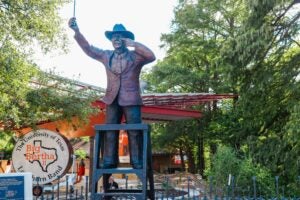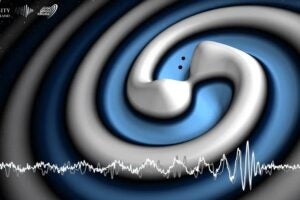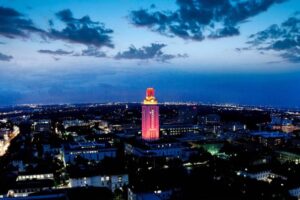AUSTIN, Texas—When the Bob Bullock Texas State History Museum opens in April of 2001, it will be a dynamic educational institution that engages visitors in the exciting “Story of Texas” through a variety of program and exhibit experiences.
Museum exhibits — some on loan from The University of Texas at Austin — will include more than 700 artifacts, 17 media and interactive experiences and three floors of diverse exhibit space covering 34,000 square feet. The exhibits will explore three themes as big as Texas history: land, identity and opportunity. In addition to the permanent exhibit space, a temporary exhibit gallery will occupy 7,000 square feet on the first floor to display short-term exhibits on topics and themes related to Texas and its history.
A unique aspect of the museum, located at the corner of Martin Luther King Jr. Boulevard and North Congress Avenue, is that it will be a non-collecting institution. This means the objects on display, which trace Texas history from before European exploration to recent times, are borrowed from collectors or other institutions. The museum, a division of the State Preservation Board, works with more than 100 statewide and national historical organizations and private individuals to spotlight artifacts that complement the exhibits’ themes. Because these objects have to be returned, the museum’s exhibits will be changing all the time.
Featured prominently among the initial items on display will be a collection from UT Austin of historical documents, books, artifacts, art works and other objects unique to Texas history.
Items loaned to the museum come from throughout the UT campus, including the Center for American History, the Texas Memorial Museum, the Texas Archaeological Research Lab, the Harry Ransom Humanities Research Center, the Benson Latin American Collection, the department of human ecology and the petroleum and geosystems engineering department.
Highlights of UT’s collection include:
- The memoirs of Alvar Nuñez Cabeza De Vaca, 1555; a life-size plaster sculpture of Sam Houston by Elisabeth Ney, 1894; Stephen F. Austin’s Prison Diary, 1833-1835, with a drawing of “Cell No. 15”; a Suffragette banner: Jane McCallum, “Mother’s Vote Protects the Home,” 1918; and a commemorative Centennial medallion — all from the Center for American History.
- A dugout canoe used by Karankawa Indians; an early 19th century fiddle and bow; a buffalo skin coat; a $2 bill from the Republic of Texas, 1835; and an 1835 salute cannon — all from the Texas Memorial Museum.
- Books, including volumes from 1661 by P. Ovidii Nasonis, selected from the Ransom Center; and a book on the Canary Islands from the Benson Latin American Collection of the General Libraries.
- A blanket belonging to Antonio Lopez de Santa Anna (1794-1876), dictator of Mexico who was known as the Napoleon of the West, from the division of textiles and apparel in the department of human ecology.
- Arrowpoints from Lamar County and Val Verde County in use at the time of contact between the Native Americans and the Europeans, gunflints from Nacogdoches County (two French “flint” or chert, and four Texas chert), “fishtail” sandals from Culberson County and a basket from Brewster County — all from the Texas Archaeological Research Lab (TARL). TARL is a nationally recognized research facility whose collections constitute the largest and best-organized archeological repository in the state.
- A metal oil field “lease” sign from the petroleum geosystems engineering department.
Lynn Denton, director of the Texas State History Museum, said partnerships with UT Austin and other entities would ensure a diversity of exhibits and state-of-the-art interactive experiences that reflect the people and history of Texas.
“As a non-collecting institution, the Texas State History Museum has both a responsibility and an opportunity to partner with other organizations and individuals to showcase seldom-seen artifacts that celebrate Texas,” said Denton, a former staff member of UT’s Texas Memorial Museum. “With the depth of the collections and resources available at UT, our closest neighbors, we are pleased to be able to feature the objects they have loaned to us for display. We truly hope that it will be a long and ongoing relationship.”
Edward C. Theriot, director of the Texas Memorial Museum, said the partnership would be mutually beneficial.
“We are one of the biggest, if not the biggest, collecting museums in Texas,” Theriot said. “The five million objects in our collections are far too many to show in any one museum. Since our mission is to ‘collect, curate, study and exhibit’ Texas heritage, we make loans to any legitimate museum that has need of our objects.
“We even have material on exhibit in Europe. Of all the museums where our collections are displayed, however, the Bob Bullock Texas State History Museum will undoubtedly be the premier showcase, and perhaps the most appropriate partner, in helping us accomplish a significant part of our mission.”
The state history museum, the dream of former Texas Lt. Gov. Bob Bullock, will become a reality on April 21, 2001 — the 165th anniversary of the battle of San Jacinto. The museum’s dramatic, three-story central exhibit atrium will feature a circa 1940 AT-6 “Texan” airplane, a full-scale windmill, the Capitol’s original Goddess of Liberty — previously housed at the Texas Memorial Museum — and a vintage “Texas” theater sign.
Supplementing the educational component of the museum, its design is a tribute to Texas’ heritage. The exterior of the museum is clad in Sunset Red granite (from the same quarry as the granite of the Texas Capitol) and is topped by a majestic copper dome.
Six sculpture panels on the front of the building evoke different chapters of the story of Texas, including Native American knowledge of the land, the aftermath of the Alamo, westward expansion of railroads and cattle drives, immigration and the growth of commerce, the oil boom and the challenge of space frontiers.
Visitors can walk under a monumental 35-foot-tall bronze star, the highlight of the museum’s Lone Star Plaza. The six flags of Texas, flying on 50-foot-tall flagpoles, frame this spectacular entry to the museum. The lobby features a dramatic, four-story rotunda with a stunning granite staircase.
A 40-foot diameter terrazzo design incorporating 47 colors to depict a campfire scene with enduring themes from Texas’ past, is centered in the floor of the rotunda. As visitors pass through the rotunda, they enter the grand lobby and stand on a polished map of Texas, which is approximately 50 feet in diameter.
A bronze statue of Bullock, who passed away on June 18, 1999 — three years after spearheading the museum proposal — is located on the second floor lobby. A limestone wall behind the statue is engraved with Bullock’s legendary words, “God Bless Texas.”
The museum also boasts Austin’s only IMAX Theatre with two-dimensional and three-dimensional capabilities projected onto an immense six-story high screen, as well as a multimedia special effects Texas Spirit Theater — the only one of its kind in Texas. Other museum amenities include a 200-seat indoor/outdoor café, a Texas Fair-themed store, classrooms and an underground parking garage that can accommodate 476 vehicles.
To ensure that all children have the chance to learn about Texas history, admission to the museum’s main exhibit area is free for anyone age 18 or under during regular museum hours.
For more information, visit the museum Web site at www.TheStoryofTexas.com



